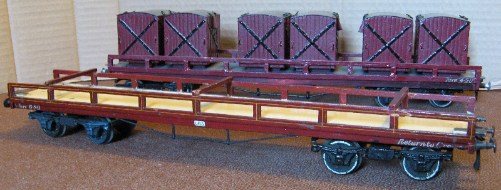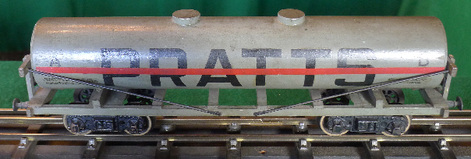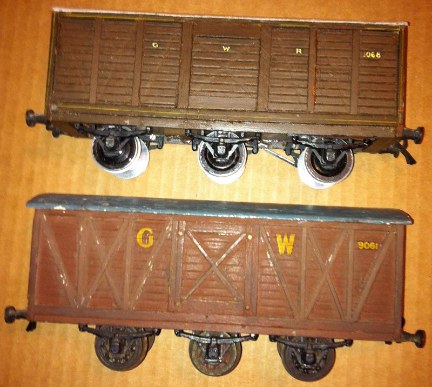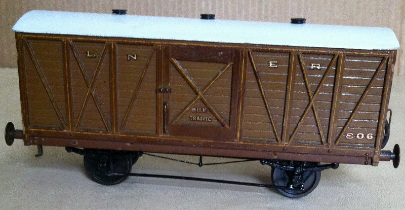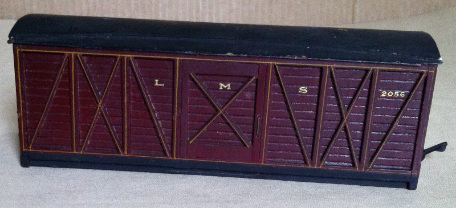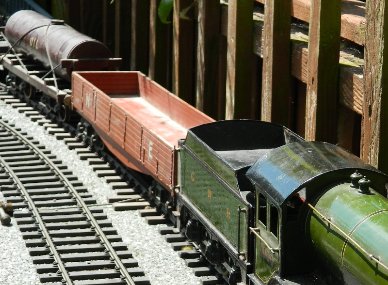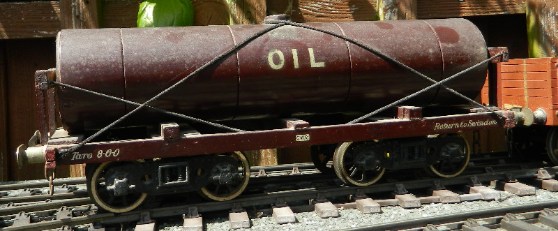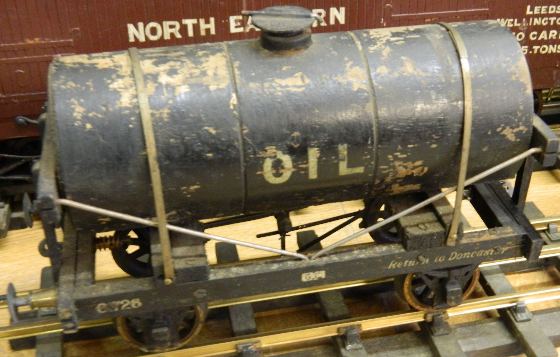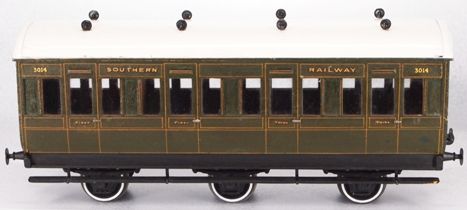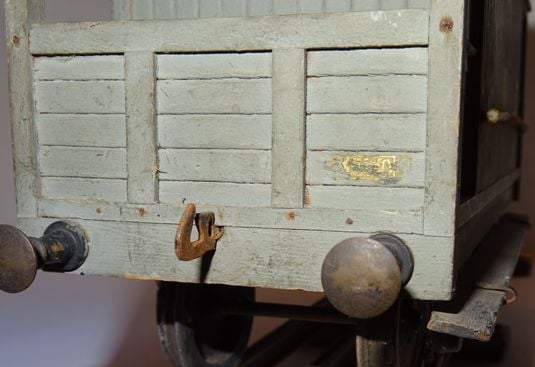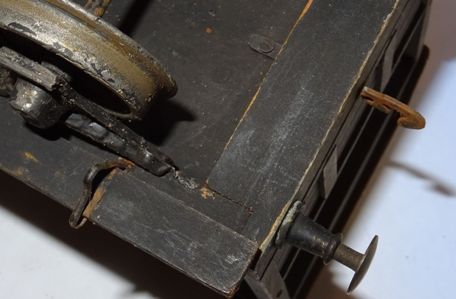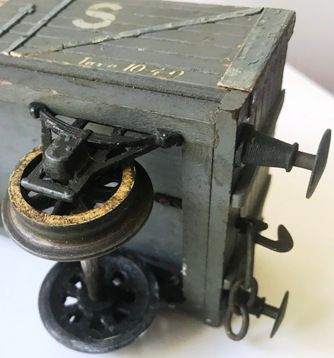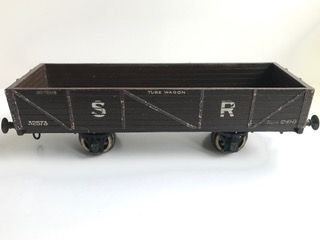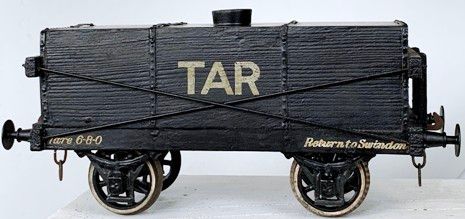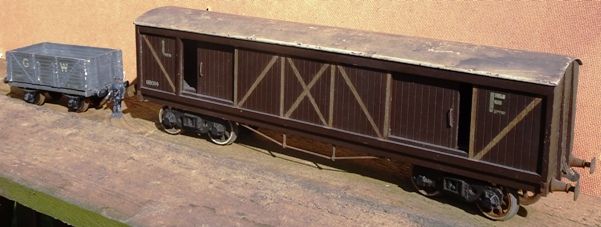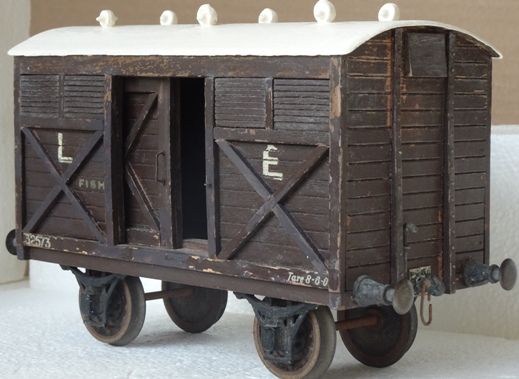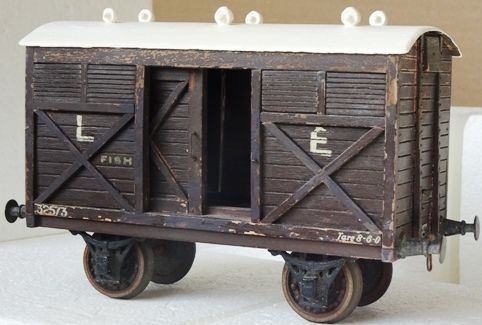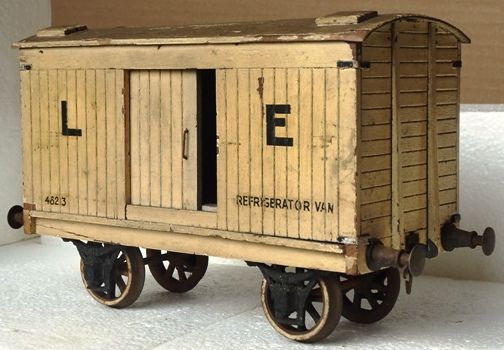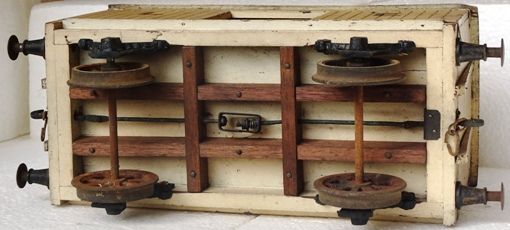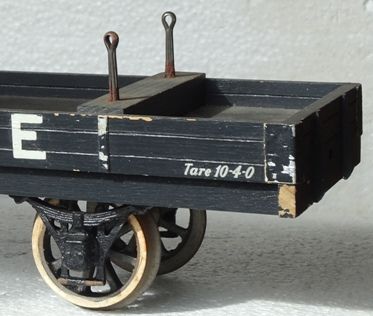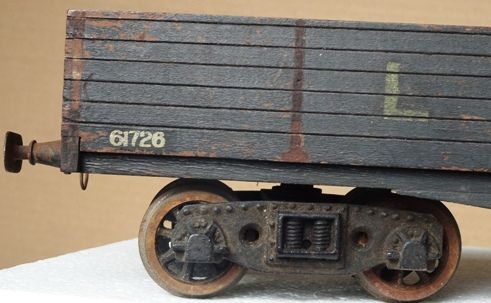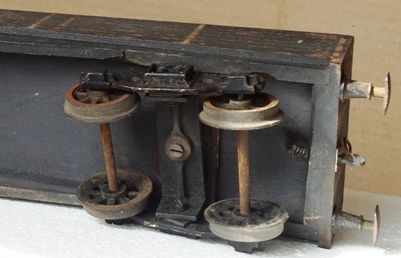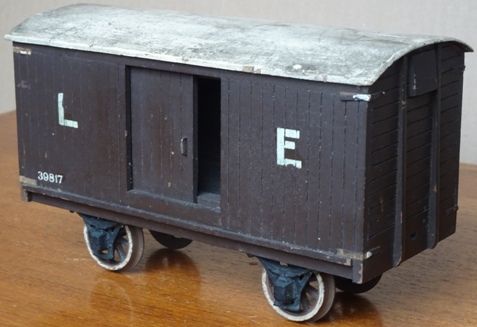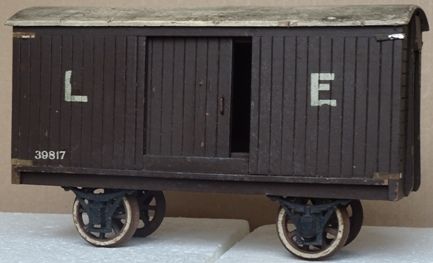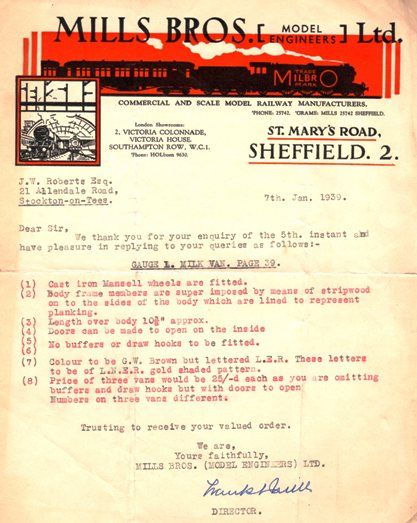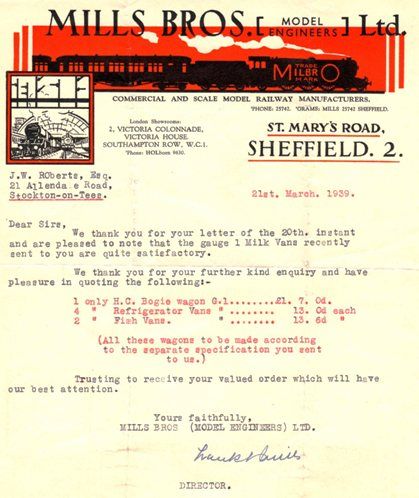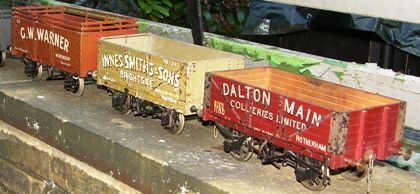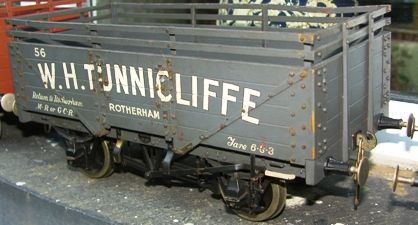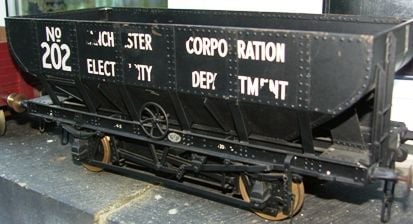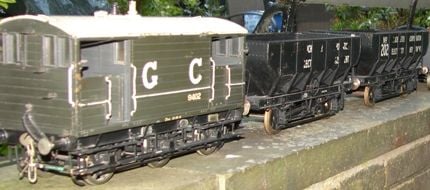
Gallery**Material added most recently to this section in March 2023*
Gallery: for additional images of rolling stock by Milbro (including Gauge One items)
Copyright is retained by M.L.Harrison for all text and photos, except for those taken by other owners and enthusiasts.
M.L.Harrison 2020, 2025 © All rights reserved.
This Gallery is mainly for rolling stock pictures, although the illustrations of these items may sometimes include locos too. The plan is to provide some additional illustrations of Mills items to supplement our other sections that deal with Mills wagons and coaches. In another part of the site we show some wagons from other companies of historical interest where relatively few pictures have previously appeared on the internet. A range of Gauge One Milbro rolling stock pictures is included below.
Examples of some types of Milbro wagons in 0 Gauge, to add to those shown in the Wagons section
Illustration G1. Two 0 gauge carriage wagons. The one at the front is in good shape, although it needs a repair to one of the ends of its sole bars, and has had some unsightly pins added by a previous owner. The one behind has been given a very crude repaint at some stage. I have managed to uncover original transfers from beneath that paint, and if time permits will try to restore its original appearance. I think the loads that have been put along the wagon may well have been added by Mills to a specific order (although they too have been subjected to repainting). The strapping on them looks similar to that which is characteristic of early Mills wagons. On this vehicle there are more of the wooden vertical supports that form parts of the sides of the wagon, and this might be the result of its being an early example. Both wagons have some quite large lettering, suggesting they were made before the later period of production, although the wires and split pins on the front vehicle are consistent with that later period.
Illustration G2a. This is the very rare PRATTS bogie spirit wagon (Gauge 0). Many thanks to its owner for providing this picture. For the transfer sheet used on these wagons, see the Artwork section of this website.
Illustration G2b. The person who sent me the picture in Illustration G2a also very helpfully sent me this photo. I believe this too is a relatively rare freight vehicle, although not as scarce as the PRATTS bogie spirit wagon.
Illustrations G3a-G3d. These four vehicles are Milbro gauge 0 milk vans, like the Southern one pictured in the Introduction section on this website. All are of similar dimensions, but two are not quite as when catalogued by the company. The first van in the top picture here has lost some of its external framing and subsequently been part-refinished or revarnished by a previous owner. The pieces of wood that form the framing on the Milbro six-wheelers sometimes become loose, with failure of the glue or distortion of the woodwork, and perhaps the owner may have felt he should make the best of a bad situation by regularising the pattern ! I hope to make and glue on some replacement pieces when time permits. The second GWR van is an earlier model than the other three, being a little coarser in its construction. The third model is an LNER one which has either been built from Mills parts as a four-wheeler, or rebuilt from a factory version; I have been advised that recollections indicate it was assembled or altered by an enthusiast rather than by the factory. It is a superb model with an impressive finish. The LMS van at the bottom had lost some of its outside framing pieces but the majority of those missing were still 'loose in the box' when I got it, and I have begun a simple restoration. Three of these vans were purchased via Ebay, despite Milbro milk vans being relatively scarce. The early GWR one, however, was bought from 'Stop the Drop'. It lacked its central pair of wheels and axle boxes when auctioned there. One of the attractive features of the three 'later period' vans here is that they retain some or all of the thin lining that runs along the sections of framing.
Some Gauge One Milbro rolling stock (wagons and coaches)
Illustration G4. Garden railway running in Gauge 1. The two wagons pictured here are Milbro models, probably both from the earlier period of production. One is a bogie brick wagon and the other a large spirit/oil wagon. I am grateful to the owner of these items and of the others in Illustrations G5-G8 for letting me have pictures of them.
Illustration G5 A closer view of the bogie OIL wagon. See also the 4-wheel OIL wagon in Illustration G8 below. For related material on early oil wagons in Gauge 0, see Illustrations W33 and W34a-W34d in the wagons section of this website.
Illustration G6 Another of the Milbro bogie vehicles on this Gauge 1 layout.
Illustration G7 Gauge 1 version of the Milbro 4-wheel carriage truck. Despite slight damage it is in good condition given its age. The SR label is oddly matched by the reference to Manchester, a reminder that this is a factory model (rather than a kit-built one with transfers selected by an enthusiast). Note the type of wheels used here; fitted on selected wagon types as well as on coaches.
Illustration G8 Close-up of a Gauge 1 4-wheel OIL wagon.
Illustrations G9a-G9c Three Milbro Gauge One Southern coaches; a First/Third, a six-wheeler, and a First/Third Luggage. I am grateful to the owner of these vehicles for providing the photographs, and for some similar portraits of 0 gauge Southern stock that are presented in our Milbro Coaches section of this site. I think that in some ways the Milbro approach to wooden coach construction seems particularly appropriate and effective in Gauge One.
Illustrations G10a and G10b. Details of a Milbro Gauge One LMS brake van that is also shown in Illustration W5d in the wagons section of this website. It can be seen that practices of construction (including the use of split pins below the bodies of brake vans) are similar to those on 0 Gauge vehicles. Many thanks to the photographer who supplied me with these pictures.
Illustration G10c. I am also grateful to the enthusiast who sent me this useful image of a Mills standard 12 tons wagon made for Gauge One. It can be seen that construction and fittings match closely what was done regularly for O gauge (with soft metal axle-boxes, card strapping, factory transfers, etc.). Different fittings could be requested if preferred.
Illustration G10d. Thanks to the person who sent Illustration G10c for also sending this portrait of a Gauge One tube wagon. Again, there is a very close match with the equivalent O gauge vehicle.
Illustration G10e. This Gauge One tar wagon can also be compared with the 0 Gauge versions shown in our Milbro wagons page. It has the metal tie bars as they appear in the firm's catalogue. I am grateful to the enthusiast who sent this picture. He has drawn attention to the strapping, which is of brass. That may have been used by the firm in this case as a substitute for the thin metal/zinc type used on its earlier vehicles, perhaps to meet a specific request or because it was convenient at a particular moment.
Illustration G11. Milbro Gauge One bogie box van. A large vehicle that was part of the rolling stock on a North of England model railway layout that I understand operated out-of-doors. Wagons had been commissioned as special orders with the owner's requested lettering (L E) instead of the insignia of a UK railway, and in some cases with particular distinctive construction features. See also Illustration W5b in our Wagons section of this website, and further illustrations below. This van is in good condition, except that the majority of the wooden sections that formed the external framing on the body sides have fallen off ! It would be easy to make some new ones and glue them on. The GW 4-wheel open wagon is for 0 gauge, and is included to emphasise the difference in size. A small metal figure may also be seen between the two wagons.
Illustrations G12a-G12d. Two more Mills Gauge One wagons from the same North of England collection as the above bogie box van. They were amended by Milbro to meet the customer's specifications, and the collection was in effect a set of 'special order' items requested through letters and notes at the end of the 1930s. This Fish Van and Refrigerator Van have opening doors. The owner subsequently made further alterations to several of his wagons, including adding woodwork below bodies (as above in G12d) and sometimes adding his own choice of buffers. The Fish Van shown here was in a very distressed state when acquired, and I had to make use of parts taken from an even more deteriorated model to renovate it ! Many wooden components had simply fallen off the exterior and vanished. Some of the wagons had clearly had heavy use. In the case of the surviving fish van I also gave the roof some paint (although that looks rather too bright).
Illustration G12e. Some wagons for this railway seem to have come without any buffers, and for the double bolster vehicle shown above the owner had not yet drilled the holes for these. This wagon was probably never used, and the only obvious signs of damage are that there is rust on the split pin fittings, and that the embossed card strapping has shed paint and deteriorated with the passage of time. The axle box covers seem to be of brass. A box van that also lacks buffers for the same reason is shown in Illustrations G12i and G12j below.
Illustrations G12f-G12h. The bogie brick wagon seems uncommon in Gauge 0, but as far as I know it was generally finished in a brownish colour (like the brick wagons made by other model companies). Illustration G4, shown earlier, includes a Milbro one in conventional colour. The Gauge One vehicle pictured now, however, was ordered from Milbro in grey, and with the owner's own livery just as on other vehicles from his layout. The wagon has lost its card strapping and corner plates, but that should be fairly easy to put right. The underside has been slightly cut into in places near to the bogies, presumably to facilitate ease of operation. I am not sure whether that was originally done by the owner or the supplier.
Illustrations G12i and G12j. A Gauge One Milbro van from the same collection, in pretty good condition, albeit with some loss of paint on the other side. This vehicle (like the double bolster wagon above) was never fitted with buffers. The owner had intended to add some of his own choosing, but clearly never managed to do that. The second world war was starting, and Milbro themselves soon became involved with other kinds of commitments. This owner's wagons may well have been amongst the last Gauge One vehicles ever ordered from the firm. This van was not given extra detailing by the owner, unlike some of the others (which he fitted with additional woodwork below the bodies, and with lines of pins to represent nails or bolts).
To add a little more to the historical picture for these wagons, we reproduce below two of the letters sent by the firm when responding to the requests of this particular enthusiast.
Illustrations G12k and G12l. A couple of the letters the firm sent out when responding to the requests of the enthusiast who purchased the above rolling stock.
Perhaps because Mills Brothers was an engineering firm, it seems to have been capable of building very realistic models when required, in even larger scales than Gauge One. I am grateful to the owner of the handsome wagons shown in our next four photos, which I understand were supplied for G.H.Swann, to run on a track with a gauge of three and three-quarter inches. An additional picture can be seen in our website wagons section as Illustration W5e.
Illustrations G13a-G13d. Very rare larger scale Mills wagons. I am grateful to the owner of this superb group of vehicles for letting me show them here. I am informed they were supplied to G.H.Swann for a track gauge of three and three-quarter inches, and were the subject of a piece in 1943 in the model railway press. See also Illustration W5e in our section on Mills wagons.
|
